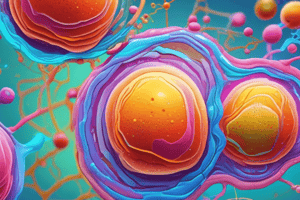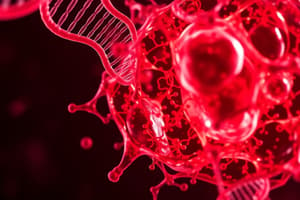Podcast
Questions and Answers
细胞核是______细胞的重要组成部分,充当控制中心并存储遗传物质。
细胞核是______细胞的重要组成部分,充当控制中心并存储遗传物质。
真核
细胞核内的DNA分子在______或减数分裂过程中复制自身。
细胞核内的DNA分子在______或减数分裂过程中复制自身。
有丝分裂
DNA复制的过程涉及将整个______DNA分子解开并分裂为两条单链。
DNA复制的过程涉及将整个______DNA分子解开并分裂为两条单链。
双股
细胞核通过控制______来调节细胞的生长、繁殖和基因表达。
细胞核通过控制______来调节细胞的生长、繁殖和基因表达。
DNA复制的机制类似于______,但涉及整个DNA分子的解开和分裂。
DNA复制的机制类似于______,但涉及整个DNA分子的解开和分裂。
细胞核内的______负责维护DNA的完整性。
细胞核内的______负责维护DNA的完整性。
(AT,GC)______,DNA
(AT,GC)______,DNA
细胞核在真核细胞中起到重要作用,其中一个功能是______。
细胞核在真核细胞中起到重要作用,其中一个功能是______。
下列关于细胞核的功能描述中,哪一个是正确的?
下列关于细胞核的功能描述中,哪一个是正确的?
在细胞核内,______是一个集中的区域,用于产生核糖体RNA亚基。
在细胞核内,______是一个集中的区域,用于产生核糖体RNA亚基。
细胞核内的______包含溶解的离子、蛋白质、酶和脂肪等分子。
细胞核内的______包含溶解的离子、蛋白质、酶和脂肪等分子。
以下哪个描述最符合细胞核的功能?
以下哪个描述最符合细胞核的功能?
下列哪个结构在核内负责产生核糖体RNA亚基?
下列哪个结构在核内负责产生核糖体RNA亚基?
细胞核在蛋白质合成过程中的主要作用是什么?
细胞核在蛋白质合成过程中的主要作用是什么?
细胞核如何确保细胞内部的基因表达和蛋白质合成得到适当的调控?
细胞核如何确保细胞内部的基因表达和蛋白质合成得到适当的调控?
细胞核如何参与细胞的生长和分裂过程?
细胞核如何参与细胞的生长和分裂过程?
细胞核如何参与细胞与环境之间的信息交流?
细胞核如何参与细胞与环境之间的信息交流?
细胞核在维持细胞遗传物质完整性方面的主要作用是什么?
细胞核在维持细胞遗传物质完整性方面的主要作用是什么?
Flashcards are hidden until you start studying
Study Notes
Understanding the Cell Nucleus: A Focus on DNA Replication
The cell nucleus is a crucial component of eukaryotic cells, serving as the control center and housing the genetic material that dictates the functions of an organism. It is important to understand the role of the nucleus and its components in maintaining the integrity of the genome, particularly during processes such as DNA replication. In this article, we will delve into the structure and function of the cell nucleus, with a focus on the process of DNA replication.
The Cell Nucleus: An Overview
Before discussing DNA replication, it's essential to familiarize ourselves with the basic structure and function of the cell nucleus. As mentioned earlier, the nucleus is a large membrane-bounded organelle within eukaryotic cells that contains the genetic material in the form of DNA organized into chromosomes. The nucleus maintains the integrity of the DNA and regulates cellular activities such as growth, reproduction, and gene expression through its control over transcription.
DNA Replication in the Cell Nucleus
During the process of mitosis or meiosis, the DNA molecules present inside the cell nucleus replicate themselves to ensure the formation of two identical daughter cells, each containing a complete set of chromosomes. This process occurs through a mechanism similar to transcription but involves unwinding and splitting the entire double-stranded DNA molecule into two separate strands. Once separated, the complementary bases (A with T, G with C) bind to the exposed single strands in the cytoplasm, eventually leading to the formation of two new double-stranded DNA molecules.
To prevent mistakes during replication, cells have a "proofreading" function called mismatch repair, which helps ensure that base pairs are paired properly. Additionally, there are chemical mechanisms like those involved in base excision repair and nucleotide addition, which can fix any errors introduced during the replication process. However, despite these precautions, errors can still occur due to various factors, including exposure to radiation, drugs, viruses, and oxidative damage to DNA. These errors can lead to mutations, which may affect gene expression and cellular functions.
In summary, the cell nucleus plays a vital role in maintaining the integrity of genetic material through DNA replication. This process ensures that daughter cells receive identical sets of chromosomes, enabling proper cell division and function. Understanding the structure and mechanism of DNA replication within the cell nucleus is crucial for deciphering the complex processes involved in genetic inheritance and evolution.
Studying That Suits You
Use AI to generate personalized quizzes and flashcards to suit your learning preferences.




